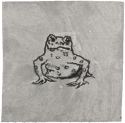The Paintings of James McNeill Whistler
M.1553
Frog

Date
Frog was drawn in 1899 as an illustration for Whistler 1899 (F)[more].

Frog, Library Of Congress
It is catalogued in MacDonald 1995 (cat. rais.) [more] (cat. no. 1553).
Images

Frog, Library Of Congress

Frog, Eden versus Whistler: The Baronet and the Butterfly, p. v, Glasgow University Library
Subject
Sitter

Frog, Library Of Congress
On 25 September 1898, Whistler described the problem of finding a frog as model:
'I was to apply for one to the Zoological Gardens, Wimbush was to find one, but in the meanwhile Teddy Godwin brought one and made a drawing of it. But the thing died. You know they say I starved it. They had put it in a paper box. Well, it must have caught a fly or two. And I thought that toads lived in amber or something for hundreds of years. Perhaps it was because I hadn't the amber.' 1
Comments
In 1894 William Eden (1849-1915) commissioned a portrait of his wife Sybil Frances Grey, Lady Eden (1867-1945). Whistler, dissatisfied with the amount (100gns) and manner of payment, retained and altered the portrait (Brown and Gold: Portrait of Lady Eden y408). After an appeal, in December 1897, the Court de Cassation let him retain the portrait but return the money. Whistler was well satisfied to see the Code Napoléon altered, to specify an artist's right to decide the fate of his works.
Whistler planned to publish an account of the affair, a compilation of letters, newspaper reports and legal documents, with William Heinemann (1863-1920), who had published the Gentle Art of Making Enemies in 1890. There was some problem with publishing in London, and, with Heinemann’s tacit agreement, Louis-Henry May in Paris took over the publication. A first proof was run off, using mainly butterflies originally drawn for the Gentle Art of Making Enemies. These butterflies were mostly replaced by new ones, in a second proof. There are at least two versions of some of the designs. They were slightly reduced in size in the final publication.
For the book, Whistler designed 15 butterflies, a club (A club on a cushion m1564), and the Frog. He also drew some butterflies which were not used (v.: Butterfly; r.: see No. 1268 m1572, Butterfly with chequered wings m1578, r.: Butterfly; v.: Butterfly with chequered wings m1579). The Baronet and the Butterfly was comparatively sparing of butterflies. Many marginal annotations, which in the Gentle Art of Making Enemies would have warranted a butterfly, did not get one. Some of the butterflies were very badly reproduced (r. and v.: Butterfly m1561, r.: Butterfly 'Encountered'; v.: Butterfly m1562). There were obviously publication problems, and it was not an entirely satisfactory venture. However, Whistler did not admit of criticism and seems, publicly, to have been entirely satisfied with the outcome.
Technique
Composition

Frog, Library Of Congress

Frog, Eden versus Whistler: The Baronet and the Butterfly, p. v, Glasgow University Library
It was drawn for publication above the Dedication in Whistler 1899 (F)[more], p. v.
Technique
It was drawn in pen and brown ink with corrections in white paint.
Conservation History
The paper darkened to orangey beige, and laid down on off-white card, which has pinholes at the edges for transfer. A proof on a small, irregular (40 x 42/30 mm) scrap of paper was stuck above the drawing to provide a scale for reproduction.
History
Provenance
- 1917: given by Elizabeth Robins Pennell (1855-1936) and Joseph Pennell (1860-1926) to the Library of Congress.
The earlier history is unknown, See MacDonald 1995 (cat. rais.) [more] (cat. no. 1553).
Bibliography
Catalogues Raisonnés
- MacDonald, Margaret F., James McNeill Whistler. Drawings, Pastels and Watercolours. A Catalogue Raisonné, New Haven and London, 1995 (cat. no. 1553) as 'Frog'.
Authored by Whistler
- Whistler, James McNeill, Eden versus Whistler: The Baronet and the Butterfly. A Valentine with a Verdict, Paris: Louis-Henry May, 1899, p. v.
Books on Whistler
- Pennell, Elizabeth Robins, and Joseph Pennell, The Whistler Journal, Philadelphia, 1921, p. 19.
Websites
- Library of Congress website at http://www.loc.gov.
Notes:
1: Pennell 1921C [more], p. 19.